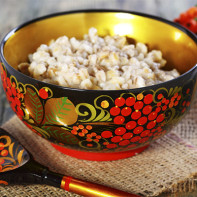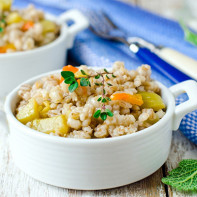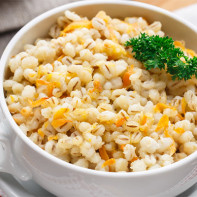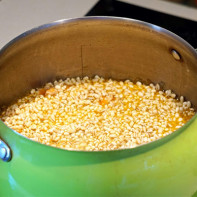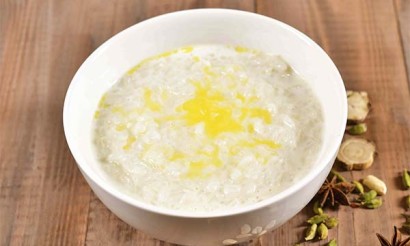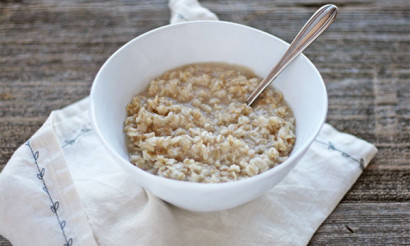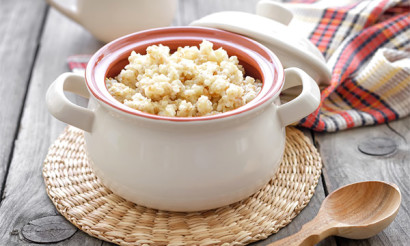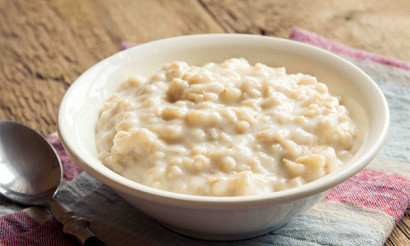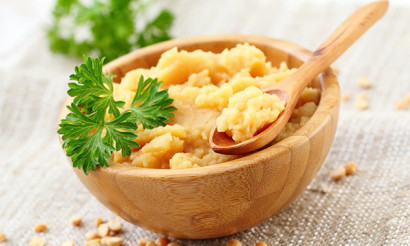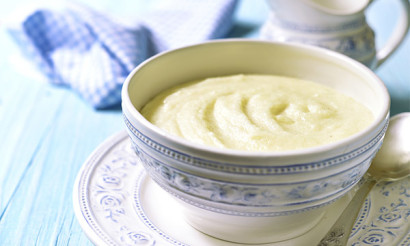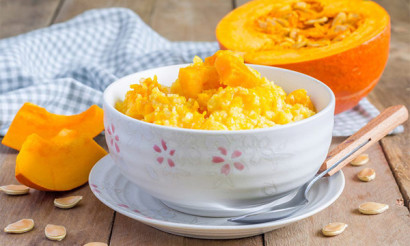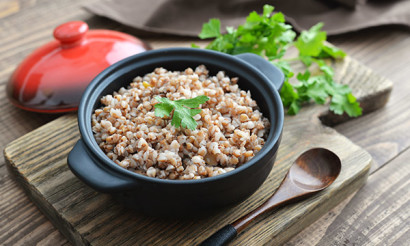Perlovka porridge: composition, beneficial properties, recipes.
Perlovka porridge is one of the most healthy dishes of Russian cuisine. Unfortunately, due to the fact that in school and army canteens this dish was prepared incorrectly, the reputation of the porridge was spoiled. But in fact, pearl barley is very useful, and if it is properly cooked, choosing a high-quality groats, it is also very tasty.
- From what kind of grain pearl barley is obtained
- Types of pearl barley
- Composition and calories
- What is the usefulness of pearl millet
- General benefits
- For Women
- For Men
- For Pregnancy
- For breastfeeding
- For children
- The benefits of pearl millet porridge for weight loss
- Pearl porridge in medicine
- Diabetes mellitus
- For pancreatitis
- For gastritis
- For bowel
- For constipation
- With gout
- Harms and contraindications
- How to choose and store pearl millet
- How to cook pearl millet: Recipes
- With water
- With milk
- In a multicooker
- With meat
- With vegetables
- With mushrooms
- Can we give dogs pearl millet porridge?
- Interesting facts about pearl millet
What is pearl barley made of?
Not everyone knows that pearl barley groats are made from barley, which itself is the best source of nutrients the body needs - even compared to wheat. In the food industry barley is made into both whole and crushed groats. There is another product of its processing - it is barley grits, crushed and well-digested. But it should not be confused with pearl barley, as they are fundamentally different products.
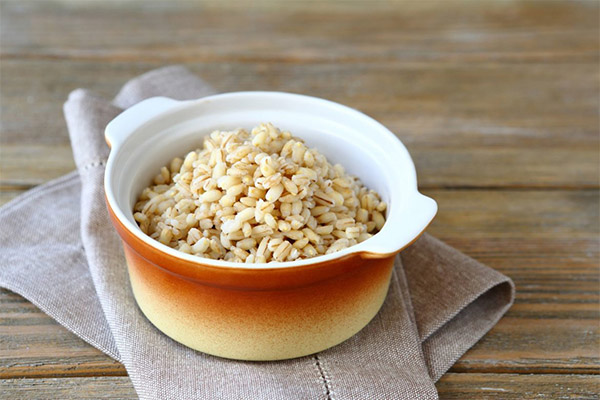
For the production of pearl groats from barley grain must be removed from the bran, that is, the top layer. The remaining grain is ground and polished. This allows it to retain a significant amount of minerals and vitamins, as well as amino acids, which are responsible for maintaining youth, the normal functioning of the body as a whole.
Types of pearl millet
Currently, manufacturers continue to produce pearl groats, which meet the standards of Soviet merchandising. Back then it was customary to sort it by size, and each type was assigned a certain number. For example:
- Cereals No. 1 and No. 2 are distinguished by large grains, which have an oval shape, and in the center runs a dark longitudinal groove, characteristic of untreated barley grains.
- Cereals #3, #4 and #5 are varieties with small grains that have a spherical shape.
In everyday life, however, many people use the classification, which was established at the beginning of the twentieth century. At that time, the largest grains were called ordinary grains, followed by "Dutch" and "semi Dutch" in decreasing order of size. The smallest grains were called "royal", that is, "royal", because in those days they were most valued.
Today, the views on good nutrition have changed, and for those who look after their health and figure, the most valuable are just regular groats with large grains. These polished grains contain more fiber and are considered the most dietary, although it takes the longest time to boil them.
At the same time, "hollandaise" is completely free of bran, and then the grain is given a round shape. Such groats are cooked much faster, but they contain more carbohydrates, they have a higher glycemic index, so it is not recommended to choose it for diabetics.
Composition and calories
The energy value of pearl porridge cooked with water is only 110 kcal per 100 grams of product. Of course, when cooked with milk, it will be significantly higher.
Scientific studies have proved that pearl groats contain much more fiber than those varieties that are made from wheat. The proteins included in its composition have a higher nutritional value than wheat proteins. It has also been found that pearl barley contains natural antibacterial substances, the properties of which will be discussed below.
Pearl porridge contains:
- B, D, PP vitamins, as well as vitamins A and E, which are antioxidants. In general, such a set provides the pearl barley with anti-inflammatory effect. It also has beneficial effects on metabolism, circulation, the nervous system, etc.
- Triglyceride and tocotrienol are two substances that can significantly lower the level of "bad" cholesterol in the blood.
- A whole set of macronutrients and trace elements, including not only zinc with its anti-inflammatory properties, or phosphorus, which is responsible for cognitive abilities, but also more rare components like molybdenum, chromium, cobalt, etc.
- Selenium - in its content pearl barley surpasses even rice, and this element is not destroyed even by heat treatment.
- Hordecine is a natural antibiotic and antifungal agent.
Special mention should be made of the amino acid lysine contained in pearl groats. It has antiviral effect, but studies have shown that it also destroys germs, including those that cause acute respiratory infections, so that the pearl barley can be considered an excellent cold remedy.
What is the usefulness of pearl millet porridge
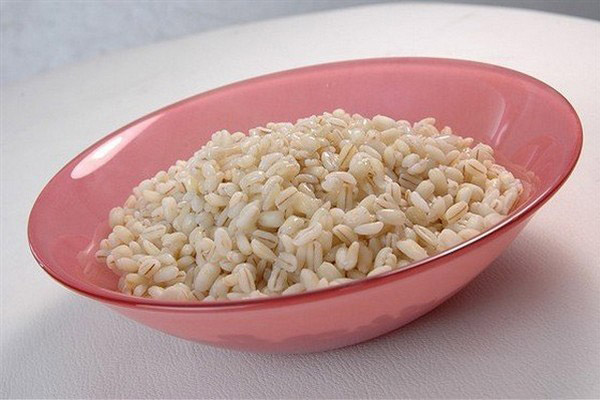
General benefits
The usefulness of pearl porridge is due to its unique chemical composition. Thanks to all of the above-described substances, pearl barley:
- provides the body with essential amino acids;
- has anti-inflammatory properties;
- Helps eliminate toxins from the body;
- Improves dental and bone health;
- prevents the formation of fat deposits;
- It has a mild diuretic effect, which helps to eliminate edema.
In the old days, this porridge was used to treat various diseases. Modern medicine recognizes its benefits, above all, in the dietary treatment of various diseases of the liver and gastrointestinal tract. Strongly boiled porridge, as well as mucous soups and decoctions made from this cereal, have enveloping properties.
For women
Pearl porridge for women is useful because it contains many useful substances, but it has a low energy value, which allows you to reduce weight with proper use. In addition, pearl barley contains amino acids, which are responsible for the elasticity and firmness of the skin. In particular, it is the already mentioned above amino acid lysine, which is also responsible for the production of collagen, which ensures youthful skin.
Vitamin D in pearl barley strengthens bones, which is especially important for women during menopause, because at this time osteoporosis can develop.
For men
As is known, members of the stronger sex suffer from cardiovascular diseases more often than women. That's why it is useful for them to include pearl porridge in their diet, as it contains substances that strengthen the cardiovascular system and help to lower the level of bad cholesterol.
Speaking about the benefits of pearl porridge for men, it should be noted that one serving contains half of the daily dose of selenium, a substance necessary for the health of the prostate gland. That is, the inclusion of this porridge in the diet can serve as a prevention of prostatitis and erectile dysfunction, from which many members of the stronger sex suffer today.
When pregnant
Perlovka during pregnancy is very useful. And this statement is justified by many factors:
- Fiber has a positive effect on the digestive process, helps to eliminate toxins from the body naturally, without resorting to drugs.
- Phosphorus, which is contained in cereals, speeds up the metabolism, helps to maintain weight, it is also necessary for the formation of the fetal skeleton.
- B vitamins are involved in metabolic processes and normalize the nervous system, they also help in the synthesis of hemoglobin, without which the normal process of blood circulation and oxygenation is impossible.
- Vitamin D is needed to strengthen teeth and bones, which is very important because a large amount of calcium from the body of the future mother is used to form the bones of the fetus.
- Vitamin E strengthens the immune system and improves blood circulation, and it is also an antioxidant, which gives skin elasticity and helps to avoid stretch marks.
Finally, pearl barley can reduce the level of "bad" cholesterol in the blood, a beneficial effect on the cardiovascular system (because the heart during pregnancy is forced to cope with double the load due to increased blood volume).
In addition, pearl barley has a diuretic effect, albeit weak. It helps to remove fluid from the body and avoid edema.
There are no particular restrictions on the use of pearl millet during pregnancy. Do not forget that doctors recommend to eat it in the morning or at lunch, and at dinner time to include in the menu more light products of sour milk.
When breastfeeding
During pregnancy a woman inevitably gains extra weight. In the postpartum period, she tries to get rid of it, and in this matter, pearl porridge will be the perfect helper. After all, it provides a full range of nutrients at the same time that it has a low energy value. This means that a young mother can give her baby healthy breast milk containing all the vitamins he needs, without getting any better at all.
Pearl porridge, among other things, normalizes digestion and helps prevent constipation, which many young mothers face in the postpartum period. It has anti-inflammatory properties, which is very useful if a woman is faced with kidney or bladder disease during pregnancy. And this groats also contain natural antifungal substances that help to prevent the development of thrush, which is also very important in the postpartum period.
Decoction of pearl millet, which is formed when cooking it, contains substances that, although they can not increase the amount of milk, but facilitate its flow and secretion, which allows you to establish breastfeeding.
For kids
For many babies, porridge is one of the first foods they receive as a complementary food. However, they begin their acquaintance with such products with gluten-free porridge, and pearl barley is not one of them, since this groat still contains gluten. Babies under the age of 1 1/2 to 2 years old are not given barley porridge at all. Then for another year a child may be offered only well-digested barley porridge, as it is better digested. If there is no allergic reaction to it, and the baby has no gluten intolerance, then from the age of three he can be given pearl barley.
This cereal is good for children because it contains a lot of fiber, vitamins and minerals, which are necessary for the proper development of the child's body. Moreover, children who receive porridge from unshredded cereals, that is classic pearl barley, grow up faster. After all, the substances in it improve the synthesis of somatotropic hormone, which is responsible for the growth and physical development of the child.
Benefits of pearl porridge for weight loss
Pearl porridge is considered a very useful dietary product. Its benefits for people who want to lose weight, there is no doubt. Moreover, there are several options for a diet based specifically on pearl barley, as this porridge helps to lose weight and at the same time supplies the body with all the useful substances it needs. In terms of vitamins, it is close to buckwheat, but the body absorbs it slowly enough, which allows you to keep a feeling of fullness longer. This can be considered an important advantage also because even from a purely psychological point of view such a diet is easier to endure.
The choice of a suitable diet variant depends on how serious a person is. Some people are better able to endure longer, but less strict diets, while others prefer the opposite option - strict express diets designed for a few days.
A more gentle version of the pearl porridge diet is designed for a week. You can eat 550-600 grams of pearl barley per day, well-cooked, so as not to complicate the work of the gastrointestinal system. It is imperative to boil the groats in water. The total amount of product is divided into three meals. In the morning, pearl porridge is prepared with the addition of dried fruit - apricots, figs or prunes (but not caloric raisins). For lunch, you can add a small piece of boiled chicken or turkey meat to the porridge. To improve digestion, a salad made with fresh seasonal vegetables is also recommended. In the evening, a glass of nonfat kefir will supplement the portion of porridge. This diet is designed for 7 days, and in this time you can get rid of 4-5 kilograms of extra weight.
There is a variant of a stricter mono-diet. The same 500-600 grams of barley porridge boiled in water without salt can be eaten per day, but this amount should be divided into five portions, enough for the whole day. A glass of kefir can be drunk an hour before bedtime. The diet is designed for 3 days. But even such a short diet can not withstand every person, because it is very strict. To make it easier, you can add 1 sour apple or some berries like cranberries or lingonberries to the porridge during the day. In these 3 days you can also get rid of 4-5 kg. The diet is good because it allows you to get in shape very quickly, for example, before an important event. And at the same time it does not require the purchase of expensive products or the ability to prepare any complex dishes.
Pearl porridge in medicine
Modern medicine considers pearl porridge a useful product. However, you should understand that it is not equally useful for all diseases. In addition, there are certain rules that must be adhered to when consuming the product.
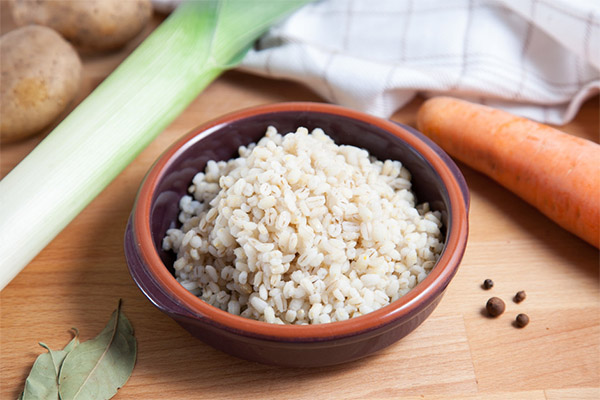
In diabetes mellitus
The glycemic index of pearl porridge, boiled in water, is only 20-30 units, so it can safely be included in the diet of people suffering from diabetes. However, it is not recommended to use groats cooked with milk, because the glycemic index of the dish in this case is much higher - 60-70 units.
It should be noted that to a greater extent, pearl barley helps with type 2 diabetes. Its regular use can even prevent this disease - given that there is a direct correlation between obesity and the risk of developing diabetes.
Pearl grits can be consumed by diabetics in the form of crumbly and viscous porridge. Allowed to add it to diet soups. No more than 150-200 grams of barley per day may be eaten. If this amount is exceeded, there is an increased risk of flatulence, dyspepsia, digestion in general can be disturbed, and in general diabetics should not overeat under any circumstances.
In pancreatitis
With acute pancreatitis shown therapeutic fasting and a very strict diet. Perlovka is included in the diet only in the chronic form of the disease, if it is already in remission. And at the same time you need to know how to cook it, so that there are no unpleasant consequences.
The fact is that pearl barley places a very high load on the pancreas. To facilitate the work of this organ, the porridge should be boiled very hard. To do this, take not too coarse barley groats (1 cup), at least 2-3 times thoroughly washed with hot water. Then pour 1 liter of water or nonfat kefir over the mentioned amount of groats and leave them to soak for 8 hours. It is best to do this overnight. In the morning, the liquid is poured off, and already slightly steamed groats are poured with hot boiled water in a 1:3 ratio and porridge is boiled for 5-6 hours. It is not necessary to stir it. It is best to cook it in an oven or in a water bath.
In pancreatitis, you cannot eat hot food, you must wait until the porridge cools down. It should be warm, but not cold, because when it cools completely, it will lose both its proper consistency and taste.
Gastritis
In the acute form of gastritis, pearl barley is prohibited. But in the chronic form you can eat mucous soups, cooked from barley groats. You can also eat heavily boiled porridge, cooked in the way described above.
In addition, the broth made from barley groats, which envelops the mucous membranes and helps to eliminate inflammation. For 100 grams of pearl barley you will need 1 liter of boiled water. First, the groats are poured with water, then incubated for at least 5-6 hours, after which the porridge is brought to a boil and boiled on the stove for 15 minutes. Then the pan is removed from the fire, the porridge is infused for half an hour, then strained. The rest of the grits can then be cooked so that the viscous porridge turned out. But the strained decoction is used for medicinal purposes - it is taken 50 ml twice a day. The duration of the treatment course is at least two weeks. Of course, it is recommended to consult a doctor beforehand.
For the intestines
With intestinal diseases, including those accompanied by inflammatory changes in the mucous membranes, the most sparing diet is prescribed. In the acute period, pearl barley is not included in such a diet, since it contains quite a large amount of fiber, due to which intestinal peristalsis increases, and in general the load on this organ grows. But with a chronic form and a state of remission, it is possible and necessary to include in the diet pearl millet porridge, but only cooked from well-cooked groats - the recipe used is the same as for pancreatitis.
There is one more important limitation. If a person has gluten intolerance, then pearl barley in such a disease is prohibited, as it will only increase intestinal problems, cause stool disorders, etc.
With constipation
As a rule, pearl porridge is recommended as a remedy for constipation because it contains large amounts of fiber, which increases intestinal peristalsis and softens stools. Even if constipation is accompanied by hemorrhoids, pearl porridge is considered an excellent laxative. But only cook it according to the dietary recipe described above. Improvement comes even after a single use of this dish. But for a stable effect, it must be included in the diet on a regular basis.
With gout.
This disease is caused by a disorder of salt metabolism. Therefore, the therapeutic diet involves the rejection of products rich in purines - they become the culprits of uric acid accumulation. Pearl groats do not contain purines, does not affect salt metabolism, so it is allowed for gout. Moreover, pearl barley in general improves metabolism and reduces inflammation (and this disease is characterized as a strong pain caused by inflammatory diseases in certain joints).
Harms and contraindications
There is a category of people for whom pearl porridge is strictly forbidden. Basically, these are those who suffer from gluten intolerance - and in the groat contains quite a lot of this protein. About celiac disease, that is gluten intolerance, they spoke relatively recently, in children it is detected fairly quickly, but many adults are not even aware that they have gluten intolerance. However, it can be recognized by the presence of the following symptoms - flatulence, bloating, diarrhea, if all these phenomena occur after consuming pearl porridge. If left untreated, celiac disease can cause muscular dystrophy and cognitive impairment over time. So in the presence of the above symptoms of pearl barley should be avoided.
However, insufficiently cooked groats can also cause irritation to the mucous membranes of the stomach, flatulence, diarrhea, or vice versa - constipation. So you need to make sure that the porridge is cooked correctly.
Pearl barley is contraindicated in acute conditions of the gastrointestinal tract and liver. In such cases, it is usually replaced by rice or oatmeal.
How to choose and store pearl millet
To choose pearl barley is not difficult in principle. Even with a visual inspection you can understand how good the product is.
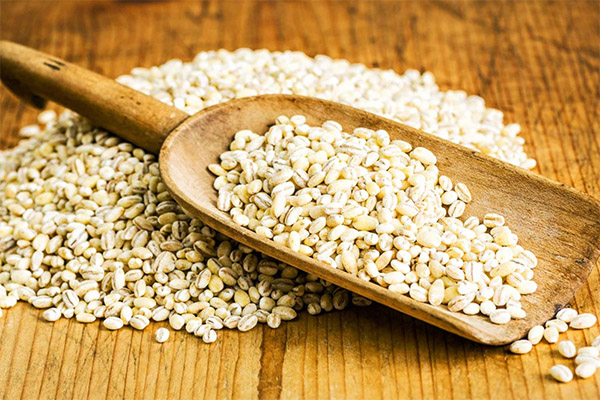
- Good grits should have a white or yellowish hue, but not brown. It is better to buy the product in a transparent package, so that you can see whether it has impurities or not.
- The packaging must be airtight, otherwise the product can not be preserved, and groats can get rancid taste and lose all its useful qualities.
As for the different types of cereals, you need to understand that the dishes made of them are different, which must be taken into account when choosing.
Large pearl barley (mentioned above #1 and #2) is recommended for use for cooking crumbly porridges and soups. Especially good with it turn out rassolnik and mushroom soups. And fine pearl barley is used for casseroles, viscous porridge (because it is well boiled), as well as vegetarian cutlets.
Like any other groats, pearl barley should be stored in a dark and dry place. It should not be exposed to the sun, because the grain still contains some fats, and in the light they oxidize. And it is clear that groats should not absorb moisture - it will simply go bad. It should be stored at room temperature. It is undesirable to keep it in plastic dishes, and it should not stay in a plastic bag for a long time. The best option - a glass or ceramic jar with a tightly closing lid.
Pearl groats can be stored for a long time, even longer than cereals made of wheat or oats, so it is quite possible to buy them in stock. If you follow all the rules of storage it can stand for a year and a half without spoiling, while millet and oatmeal are not stored longer than 9-10 months.
How to cook barley porridge: Recipes
Regardless of which recipe will be chosen in the end, the pearl barley groats must first be boiled. To do this, it must be properly prepared. Grain should be sorted and thoroughly rinsed to remove starchy compounds. But the preparation is not limited to this. First, the grain is soaked in cold water. If we are talking about large varieties, you need to leave them for 10-12 hours, small ones can soak even faster. In this case, the ratio of groats to water should be 1:5, this is the golden ratio - a glass of groats per 1 liter of water.
If everything has been done correctly, the porridge can be cooked quickly enough. There are different ways to cook it. Pearl porridge can be cooked in water, meat or vegetable broth, as well as milk.
Ready pearl porridge is served with fish, meat, mushrooms and vegetable salads. Sometimes it is enough just to boil the pearl barley and season it with chopped and lightly fried onions, although it cannot be called a diet option. In the Lent, pearl porridge can be served with chopped nuts, poppy seeds, prunes, apricots, use honey for dressing.
With water
Soak the groats as described above. In the morning, the water is drained, the grain can be rinsed again, and then pour fresh boiled water in the proportion of 1:3. It is best to cook porridge in a cauldron. It can be put in the oven, and so it will turn out more delicious and crumbly. Modern types of pearl porridge are usually boiled for 1-2 hours. All this time it should stand under the lid, there is no need to stir it. The finished porridge should have a beautiful beige hue. Before serving, add a little butter. If desired, you can pour instead of it fat cream to get a more delicate taste.
With Milk
Cooked with milk, porridge can not be called a dietary dish, but it is still useful. Soak the groats in the way described above. In the morning, the water, in which the pearl millet was standing, is drained. Meanwhile, they take lean milk and heat it to 40 degrees. The ratio in this case - 1:10. That is, for 200 g of pearl barley you should take 2 liters of milk. Pour the groats with milk, bring the porridge to a boil and cook for 5-6 minutes, without covering with lid. Make sure that the milk does not burn. Then the pot is removed from the fire and then cook the porridge in a water bath - so in a regular kitchen you can recreate the same conditions as in a traditional Russian oven. It is not necessary to stir the porridge all this time. In the end, it may take 5-6 hours, but the taste of the dish will be very delicate.
In the multicooker
To cook barley in the multicooker is not difficult. To do this, take 1 cup of groats for 3 cups of water, salt is added to taste. Pour the groats and water into the bowl of the multicooker, set the mode "Stew" or "Pilaf" depending on the model. If the groats soaked beforehand for a long time, then it will cook for an hour. But after that it is still 5-10 minutes do not take out of the multicooker, so that it hardens.
With meat
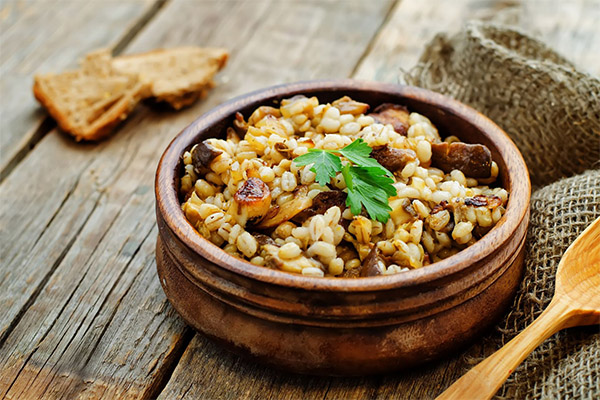
Pearl porridge goes well with different kinds of meat, including pork. You can prepare it this way: 150 g of pearl barley, 100 g of lean pork, 2 garlic cloves, 1 onion and 0.5 l of vegetable broth. Soak the barley in water for 6 hours and boil until half ready. Chop onions and garlic, then lightly fry in a pan, add chopped meat and also lightly fry. Then add the pearl porridge, stir to soak in the oil, add the vegetable broth and cook under a closed lid for at least 40 minutes over low heat until the pearl porridge is soft. Ready porridge can be sprinkled with grated Parmesan.
With vegetables
Perlove porridge can be cooked with any vegetables, such as tomatoes, green beans, pumpkin, etc. For example, you can use the following recipe: 1 cup of fine peppercorns, which is cooked quickly, take 1 bell bell pepper, 200 grams of fresh or dried tomatoes (in season), 100 g green beans and the same amount for green peas, 400 ml of water, one onion, pepper, salt, oil - to taste.
Onion is finely chopped and lightly fried, then add chopped tomatoes, diced peppers, beans and peas, for a while stew over low heat. Then add pre-soaked groats, pour water, salt, stir and bring to a boil. Braise until the groats are ready under a closed lid over low heat.
With mushrooms
Pearl porridge with mushrooms - a traditional dish of Russian cuisine. Most often for its preparation take dried porcini mushrooms. But it can also be cooked with chanterelles, and in modern conditions mushrooms are often used.
To prepare the porridge you will need: 1 cup of barley groats, a handful of dried ceps, 1 carrot, 2 medium-sized onions, 2 tomatoes, salt to taste.
It should be noted that the mushrooms and grits for this dish are soaked in different dishes. In this case, it is enough to hold mushrooms in water for 2 hours, and pearl barley, depending on its type - from 5 to 8 hours. Porridge is boiled separately. After about an hour, finely chopped mushrooms are added, from which the water is drained beforehand. When the porridge boils, carefully remove the foam. Meanwhile, the onion and carrots are peeled and chopped in the usual way, the tomatoes are peeled (it is easier to put them in boiling water) and diced. Onions and carrots lightly fry, add tomatoes and stew a little. When the porridge is almost ready, put the vegetables on top and keep on low heat with the lid closed for another 5-10 minutes.
Can I give barley porridge to dogs?
While it is allowed to give some porridge to dogs in order to replenish vitamins and minerals, pearl barley is not among the permitted products. They should not be given to dogs. Interestingly, the reason for this is a large amount of fiber. For the human body, this is rather an advantage. But in dogs pearl barley can cause allergic reactions and severe diarrhea. In this case, such porridge, even boiled, is poorly digested by the body of animals.
Interesting facts about pearl millet
For a long time, pearl barley was called somewhat contemptuously manly rice (and in later times it was unequivocally called "shrapnel" because poorly cooked porridge promotes increased gas production). But in fact, in the old days this dish was also found on the tables of the aristocrats. For example, King Peter I loved pearl millet. It is believed that with his light hand this dish appeared in the army ration.
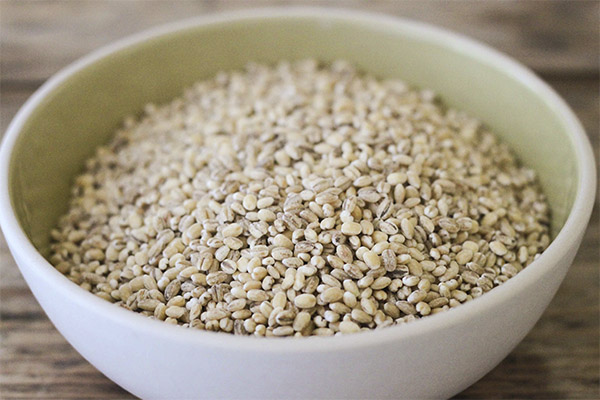
However, in those ancient times the grain was soaked in cold water for 10-12 hours to get a tasty crumbly porridge. But the rhythm of life gradually accelerated, the long preliminary soaking quite quickly forgotten, and most people remember pearl barley exclusively as a slimy, somewhat rubbery taste porridge, which was fed in pioneer camps and army canteens. It is interesting that today in the Russian army the traditional pearl barley has practically been abandoned, replacing it with more expensive types - rice and buckwheat. However, it is still used to dress soups and casseroles. The fact that pearl barley contains phytohormones - that is, hormone-like substances that resemble in their action estrogens. If it is included in the diet from time to time, this will not affect the hormonal background. But the prevalence of pearl millet in the early 1990s in the military menu had a negative impact on health - this is the conclusion reached by physicians.
By the way, barley porridge was popular not only with Peter I. It was also served to the table of the last Russian Emperor Nicholas II. However, some sources suggest that the love of the Emperor to this porridge, as well as serving it to the festive table - no more than a beautiful legend. And the last Russian tsar preferred dishes of English and French cuisine, even if they were simple.
Legend has it that Hippocrates recognized the benefits of pearl millet. However, it is more likely that we are simply talking about barley grain, as no porridge was produced according to modern technologies at that time, and no one would engage in multiple sifting and polishing of the grain. But barley was respected in the ancient world and was included in the diet of Roman gladiators to ensure their strength and endurance.
There is also a legend that the name "pearl barley porridge" ostensibly originated because barley grains reminded people of pearls. However, linguists usually do not agree with this theory. The more plausible explanation is that the name appeared only in the 19th century, when people wished to ennoble the traditional product. However, if peasants in the Middle Ages knew as much about pearl millet as scientists know today, they would probably have called this porridge pearl.
«Important: All information on this site is provided for informational purposes only. purposes only. Before applying any recommendations, consult a health care professional. specialist. Neither the editors nor the authors shall be liable for any possible harm caused by materials."


